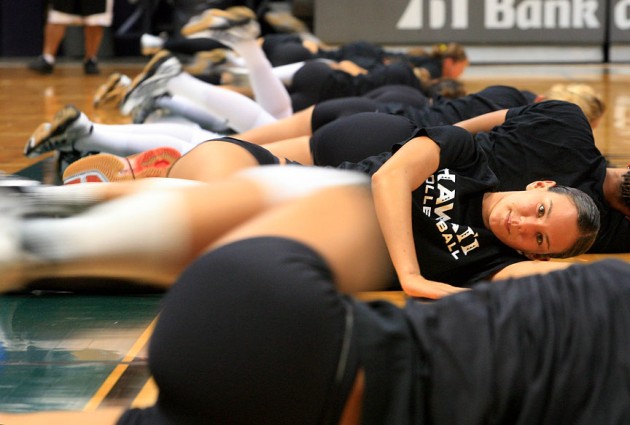
Stretching Exercises
Forward Hand Walks
The deltoid muscle in the shoulders is one of the primary muscles used in volleyball. Stretching this muscle elongates the connecting tendons and ligaments, improving your flexibility, range of motion and ability to perform overhead movements such as setting or spiking the volleyball. It also stretches the calves, hamstrings and lower back, which are muscles required for quick and explosive movements in volleyball. This stretch also stabilizes the shoulder and helps prevent injury. Enter the starting position by standing. While keeping your legs and knees straight, bend forward and place both hands on the floor. Contract your abdominal muscles and begin to walk your hands away from your feet. At the apex of this forward movement with the hands, begin to walk your feet back up to your hands, remembering to keep your knees and legs straight. Perform this stretch before practice or competition to increase the reflexive response of your muscles, prevent injury and increase your range of motion and explosive movements.
Arm-Up Rotator Stretch
The muscles of the forearm and upper arm, primarily the biceps and triceps, are especially important in volleyball. Stretching these muscles is essential in preventing injury and improving your overall strength and arm movements. You will need a wand or broomstick to perform this exercise. Begin by standing with both arms extended. Bend your right forearm upward so that it forms at 90 degree angle. Place the broomstick or wand in your right hand and bring it behind your elbow. Use your left hand to pull the bottom of the broomstick forward. Hold this stretch for 10 seconds and relax. Perform one set of 10 repetitions, once daily, on both arms to prevent a rotator cuff injury.
Lunging Hip Flexor Stretch
Volleyball requires flexibility and strength in the hips and pelvis. The hip flexors are responsible for bringing the thighs up to the abdomen and rotation movement in the hips. Stretching these muscles is essential for running, jumping and increasing your range of motion while covering the court and playing volleyball. Enter the starting position by standing with your legs and knees straight. Enter a lunge by stepping forward with your right leg, remembering to keep your left leg straight and the left foot pointing forward. Bend your right knee, ensuring to keep that foot planted on the ground. Lean slightly forward and keep your chest high. Hold this stretch for 5 seconds and return to the starting position. Perform one set of 10 repetitions on both legs.
Quadriceps Stretch
The calf muscles and upper legs enable quick and explosive movements in the volleyball. These muscles are vulnerable to overuse injuries, primarily the quadriceps, due to the extensive jumping required in volleyball. Begin by standing, ensuring that your legs and knees remain straight. Grab your right foot with your right arm and bring the heel of your foot toward your buttocks. Continue this flexion until you feel a stretch in your thigh. Hold this stretch for 10 seconds and return your leg to the starting position. Perform one set of 10 repetitions on both legs, once daily.
For more fun volleyball news click here.
Check out the news from our Phisiotherapy section, every Monday a new story! Tomorrow read about Achilles Tendinopathy.